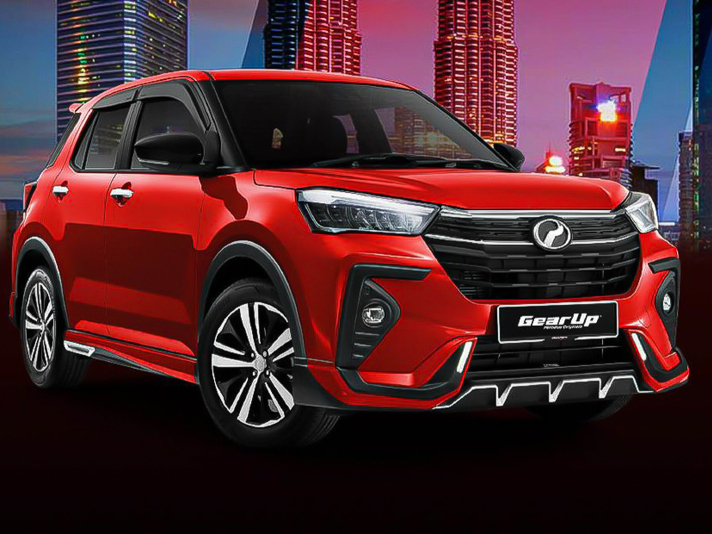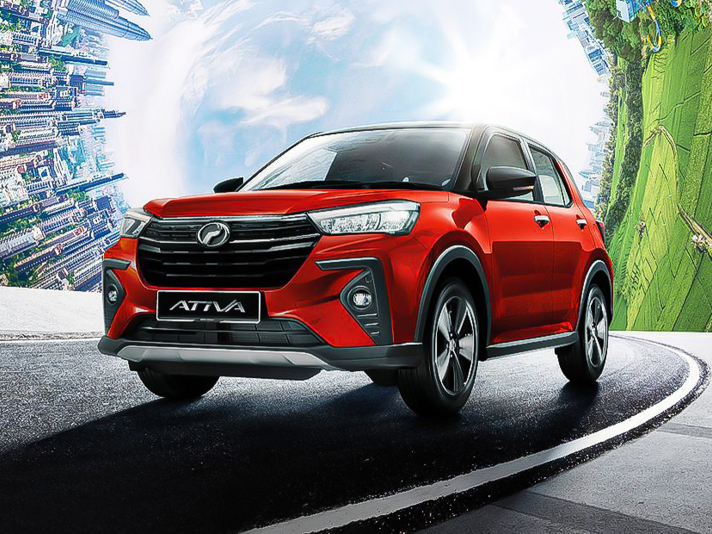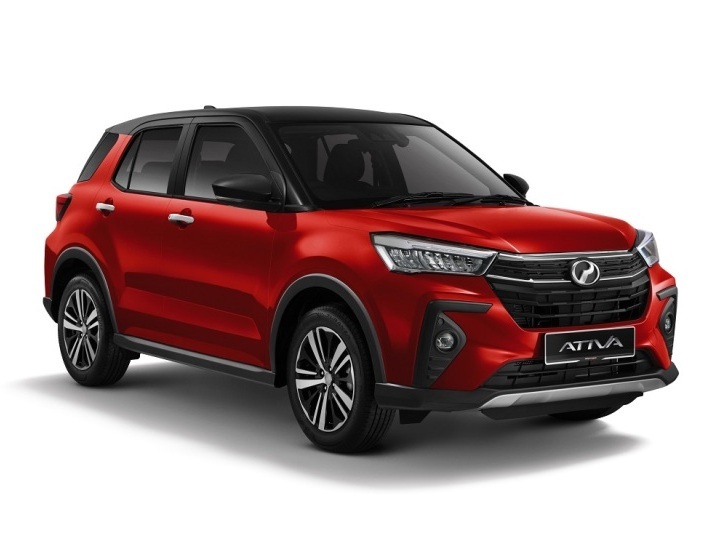Q
Is Ativa a SUV or MPV?
The Perodua Ativa is a compact SUV that slots right into the B-SUV segment. Its design blends SUV practicality with a stylish look, sitting tall with a decent amount of ground clearance – perfect for Malaysia's varied road conditions, whether you're navigating city streets or tackling the occasional rural stretch. Under the hood, you'll find a 1.0-litre turbocharged engine that strikes a nice balance between fuel efficiency and performance, making it a solid fit for local drivers' everyday needs.
Now, the main differences between SUVs and MPVs come down to body structure and intended use. SUVs generally lean towards a sportier vibe and versatility, ideal for individuals or small families. MPVs, on the other hand, prioritize space and passenger comfort, catering more to larger families or business use. As an SUV, the Ativa offers flexible seating configurations and respectable cargo space, but it doesn't go all-in on three rows of seats or maximum passenger capacity like an MPV would.
In the Malaysian market, SUVs are gaining more and more traction because they handle daily city commutes just fine while also being up for the occasional outdoor adventure. The Ativa's positioning hits that sweet spot, giving budget-conscious buyers who still want that SUV flair a really compelling option.
Special Disclaimer: This content is published by users and does not represent the views or position of PCauto.
Related Q&A
Q
How long can an Ativa battery last?
The battery life of the Perodua Ativa typically ranges from 2 to 3 years, depending on usage habits and environmental factors. Malaysia's hot and humid climate can accelerate battery aging, so it's advisable to regularly check the battery status to ensure optimal performance. Key factors affecting battery lifespan include frequent short trips (which prevent full charging), usage of electronic devices, and prolonged parking. Drivers can extend battery life by avoiding excessive use of electronics when the car is parked and taking regular long drives to help fully charge the battery. It's worth noting that most modern car batteries are maintenance-free, but you should still pay attention to the battery warning light or have it professionally tested. Difficulty starting the vehicle or dimmed lights may indicate the need for a replacement. For hybrid models, the high-voltage battery system is designed to last longer, but the 12V auxiliary battery still requires similar maintenance. It's recommended to follow the original maintenance schedule and have the battery inspected and replaced at authorized service centers to ensure the stable operation of the vehicle's electrical system and to benefit from the quality assurance of genuine parts.
Q
How much is Ativa 2021 in Malaysia?
The 2021 Perodua Ativa's price in Malaysia varies by trim level. The entry-level Ativa 1.0L X starts at around RM62,500, while the higher-spec Ativa 1.0L AV goes for approximately RM72,400. Actual prices might fluctuate slightly depending on regional discounts or promotional offers. As Perodua's first SUV with a 1.0-liter turbocharged engine, the Ativa has drawn in many buyers with its fuel efficiency and sleek looks. It also comes packed with advanced safety features like the ASA 3.0 (Advanced Safety Assist) system, which includes pre-collision warning and lane keep assist. With decent ground clearance and good cargo space, this car is perfect for city driving and family use. If you're thinking about getting an Ativa, head down to your nearest Perodua dealership for a test drive to get a real feel for how it handles and check out the specs. While you're there, ask about their latest promotions—you might score some extra perks or free accessories.
Q
How many cc is Ativa?
The Perodua Ativa is a highly popular compact SUV in the Malaysian market. It is powered by a 1.0-liter three-cylinder turbocharged engine with an actual displacement of 998cc, falling into the category of small-displacement turbocharged engines. This design ensures power output while also taking fuel economy into account, making it very suitable for city driving. The Ativa has a maximum power of 98 horsepower and a peak torque of 140 Nm. Paired with a D-CVT transmission, it offers smooth power delivery and a responsive performance, which is ideal for daily commuting and family use.
It's worth mentioning that small-displacement turbocharged engines have become increasingly popular in the Malaysian market in recent years. They can provide decent power performance while reducing fuel consumption and emissions, meeting the dual demands of modern consumers for environmental protection and economy. The Ativa is also equipped with an advanced Safety Assist system, including functions such as pre-collision warning and lane-keeping assist, which further enhances driving safety.
For Malaysian consumers with a limited budget who want to enjoy the practicality and technological features of an SUV, the Ativa is a worthy option. Its cost-effectiveness and low maintenance costs are also what make it attractive.
Q
How many cylinders are in Perodua Ativa?
The Perodua Ativa is equipped with a 1.0-liter three-cylinder turbocharged engine, so it has a total of three cylinders. This engine adopts the advanced Dual VVT-i technology, which can provide good power output while taking fuel economy into account. It's very suitable for the frequent start-stop traffic conditions in Malaysian cities. The design of the three-cylinder engine is becoming more and more common in small SUVs because it can achieve high efficiency in a compact size and reduce the overall vehicle weight at the same time, which is very practical for daily commuting. The maximum power of Ativa's engine is 98 horsepower, and the peak torque is 140 N·m. It is mated with a D-CVT gearbox, and its overall performance is smooth and reliable. As a popular SUV model under Perodua, Ativa is loved by many Malaysian consumers, especially young families and urban commuters, thanks to its small and flexible body and economical fuel consumption. Although the three-cylinder engine requires higher technical requirements in noise and vibration control, the modern automotive industry has significantly improved these problems through technologies such as balance shafts to ensure driving comfort.
Q
What is the starting price of Ativa?
As one of the most popular entry - level SUVs in the Malaysian market, the starting price of the Perodua Ativa is around RM62,500 (excluding insurance). This is the base price for the 1.0L Turbo AV version. For the higher - spec 1.0L Turbo H version, the price starts from around RM72,000. The actual price may vary slightly due to dealer promotions or optional packages.
The Ativa is powered by a 1.0 - liter three - cylinder turbocharged engine, paired with a D - CVT transmission. It focuses on fuel economy, with an official fuel consumption data of 18.9 km/L. It also comes with the ASA 3.0 advanced safety assist system, including functions like pre - collision warning and lane - keeping assist. Its cost - effectiveness is quite competitive among B - segment SUVs.
It's worth noting that the Ativa is a sister model of the Japanese Daihatsu Rocky and Toyota Raize, sharing the DNGA modular platform. However, it has adjusted the suspension settings according to Malaysian road conditions and uses local parts to control costs.
When buying a car, it is recommended that consumers compare the road tax rates in different states and pay attention to the after - sales promotion packages regularly launched by Perodua, such as free maintenance times or low - interest loans. These can further reduce the cost of car ownership.
Q
Does Ativa have auto brake?
The Perodua Ativa is indeed equipped with an Autonomous Emergency Braking (AEB) system, which is part of its advanced safety assistance features. This system uses a front - mounted camera and radar to detect vehicles or pedestrians ahead. When a potential collision is detected, it automatically triggers the brakes to reduce the risk of accidents, making it particularly suitable for the complex urban traffic environment in Malaysia.
In addition to AEB, the Ativa also comes with active safety features such as Lane Keeping Assist and Adaptive Cruise Control. Overall, it has achieved a leading level of protection in its class.
It's worth noting that the Autonomous Emergency Braking system may have different technical names among different brands. For example, Toyota calls it the Pre - Collision System (PCS), while Honda refers to it as the Collision Mitigation Braking System (CMBS). However, their core functions are similar.
As a car owner, it is recommended to regularly check the cleanliness of the radar and camera to ensure the system's sensitivity. At the same time, it's important to understand that such systems are only auxiliary functions, and maintaining concentration while driving remains the primary guarantee for safety.
According to data from the Malaysian Road Safety Research Institute, vehicles equipped with AEB can reduce rear - end collisions by approximately 40%. This kind of technology is gradually becoming the mainstream configuration for new local cars.
Q
Can Ativa use CarPlay?
The Ativa is compatible with CarPlay. Some users have reported that the 2021 Perodua Ativa in Malaysia can use CarPlay. However, the data cable provided as a bonus doesn't work, causing constant disconnection. You need to use the Type-C 3.0 fast-charging data cable that comes with the original phone to avoid disconnection. Also, the overseas car infotainment system must have Easy Connect to use CarPlay.
CarPlay is an in-vehicle system launched by Apple Inc. in the United States. It seamlessly integrates users' iOS devices and iOS experience with the dashboard system. Once successfully connected, you can use the voice assistant Siri on your phone to control the in-car multimedia system. You can also operate through the touch screen on the car's dashboard or the physical buttons on the steering wheel. This makes driving operations more convenient, reduces the time drivers spend on operations while driving, and improves safety.
Q
Is Ativa 4 wheel drive?
The Perodua Ativa is a popular small SUV in the Malaysian market. However, it's not a four-wheel drive (4WD) vehicle. Instead, it uses a front-wheel drive (FWD) system. This design emphasizes fuel economy for city driving and daily practicality. The Ativa is equipped with a 1.0-liter turbocharged engine paired with a D-CVT transmission. Its power performance is suitable for city commuting. Meanwhile, its compact body size and high ground clearance also improve its passability on common road conditions in Malaysia.
For users who need four-wheel drive, they can consider other models such as the Proton X70 (some versions offer AWD) or the Toyota Rush (with an optional 4WD version). These models are more suitable for off-road or slippery roads. Four-wheel drive systems are generally divided into all-wheel drive (AWD) and part-time four-wheel drive (4WD). The former is suitable for all-weather road conditions, while the latter focuses more on off-road performance. When making a choice, you need to weigh fuel consumption, cost, and driving scenarios according to your actual needs.
In Malaysia's rainy climate, four-wheel drive models can provide better grip. However, front-wheel drive vehicles with an electronic stability system (like the ASA 3.0 standard on the Ativa) can also meet most daily needs.
Q
Is Ativa a safe car?
As a popular small SUV in the Malaysian market, the Perodua Ativa's safety performance meets the mainstream level of models in its price range. It comes standard with basic features such as dual airbags, ABS + EBD, Electronic Stability Control (ESC), and Hill Start Assist. The high - end version also adds side airbags and advanced active safety systems like Autonomous Emergency Braking (AEB) and Lane Departure Warning. Overall, its safety equipment is better than entry - level models in the same class but not as good as more premium products.
According to the ASEAN NCAP test, the Ativa received a five - star rating, with an 83% score in the adult occupant protection category. This shows that its body structure can effectively protect passengers in a collision. However, it should be noted that these tests are conducted under standard conditions, and the results in real - world road accidents may vary depending on the collision angle and speed.
For Malaysian consumers, the safety performance of the Ativa meets the needs of daily urban commuting. However, if you frequently drive long - distance on highways, it is recommended to choose a version with a more comprehensive active safety system.
It's important to note that the safety performance of any vehicle highly depends on proper use, including wearing seat belts, obeying speed limits, and regular maintenance. Good driving habits, along with maintaining an appropriate following distance and having a defensive driving mindset, can often prevent accidents more effectively than vehicle configurations.
Q
Does Ativa save fuel?
As a B-Segment SUV equipped with a 1.0-liter turbocharged engine, the Perodua Ativa really performs well in terms of fuel economy. Official data shows that its fuel consumption is about 18.9 km/l. This figure is quite fuel-efficient among vehicles in the same class, making it especially suitable for the stop-and-go traffic conditions in Malaysian cities. This is mainly due to its D-CVT transmission and engine auto start-stop technology, which can effectively reduce unnecessary fuel consumption.
If you want to further improve fuel efficiency, it is recommended to keep up with regular maintenance, use the recommended viscosity of engine oil, and avoid bad driving habits such as rapid acceleration and hard braking. Actually, apart from the vehicle's own design, driving style and road conditions also play a significant role in fuel consumption. Small SUVs like the Ativa are more flexible and fuel-efficient for urban commuting than large SUVs. However, if you often drive long distances on highways, the fuel consumption advantage may not be as obvious.
In addition, the proper use of air conditioning in Malaysia's hot weather can also affect fuel consumption. It is recommended to set the temperature between 23 - 25 degrees Celsius to achieve energy-saving results.
Popular Cars
Model Year
Car Compare
Car Photo
Latest Q&A
Q
What does 3.5 mean in cars?
In the automotive world, "3.5" typically refers to engine displacement—3.5 liters to be exact. This number represents the total volume of all cylinders during one combustion cycle. Generally, a larger displacement means more power, but it can also lead to higher fuel consumption.
You’ll often find 3.5L engines in midsize to large sedans, SUVs, or performance-oriented models, where they deliver strong torque and horsepower—ideal for highway cruising or heavy-duty needs. Sometimes, "3.5" appears in a car’s trim name, indicating a higher-spec version equipped with this engine.
Naturally aspirated or turbocharged setups can change how a 3.5L engine performs—turbocharging boosts efficiency, while hybrid systems might help cut down on fuel use. If you’re considering a car with this engine, it’s worth test-driving to feel the power delivery firsthand. And don’t forget to factor in real-world fuel economy and maintenance costs to see if it fits your needs.
Q
Is a 3.0 liter engine a V6?
A 3.0-liter engine doesn’t always mean a V6 configuration—though V6 is indeed the most common layout for this displacement. The actual engine type depends on the vehicle’s design. For example, some BMW models use an inline-six, while certain Porsches feature a flat-six, both in 3.0-liter form. Even some V8s can achieve a 3.0-liter working volume with cylinder deactivation.
The relationship between displacement and cylinder count boils down to individual cylinder capacity and layout. A typical 3.0L V6 averages around 500cc per cylinder, striking a balance between power delivery and smoothness.
Worth noting: Turbocharging has blurred the lines—smaller engines (like high-output 2.0T units) now match the power of naturally aspirated 3.0Ls. When evaluating engines, don’t just fixate on displacement or cylinder count. Factor in tech like direct injection and variable valve timing—brands tune even identical displacements differently. Some prioritize low-end torque for city driving, while others favor high-revving performance for highway cruising.
Q
What is the difference between a 2.4 L and a 3.0 L engine?
The key difference between 2.4L and 3.0L engines boils down to displacement. The 3.0L's larger cylinder volume means it gulps more air and fuel per combustion cycle, delivering roughly 20-30% more horsepower and torque than the 2.4L – perfect for drivers who prioritize acceleration or towing capability.
That said, the 2.4L shines in fuel efficiency, especially for city driving. Both engines might pack modern tech like variable valve timing or direct injection, but 3.0L variants often get extra performance goodies—think twin-scroll turbos or high-pressure fuel systems.
Just remember: bigger displacement typically means higher road taxes and running costs. Many models offer both options, so choose based on your needs—whether it's power or pocket-friendly mileage.
Q
Is the 3.5 EcoBoost a V6 or V8?
Ford's 3.5L EcoBoost is a twin-turbocharged V6 engine—not a V8 configuration. It combines direct injection and turbocharging tech to deliver near-V8 power from a more compact six-cylinder package. Typical versions punch out around 375 horsepower and 475 Nm of torque, commonly found in F-150 pickups and Explorers. The real win here is balancing performance with decent fuel efficiency.
The core difference between V6 and V8 layouts boils down to cylinder count and refinement—V8s traditionally offer smoother power delivery and higher peak output, but at the cost of added weight and thirst. Modern turbo V6s like this EcoBoost have narrowed that gap significantly. It’s Ford’s poster child for giving buyers the best of both worlds: robust towing capability without the daily-driver penalties of a bulkier V8. If you want American muscle without guzzling fuel or wrestling with a ponderous rig around town, these force-fed six-cylinders hit the sweet spot.
Q
What does 2.4 L I4 mean?
The 2.4L I4 refers to a 2.4-liter displacement engine with an inline-four cylinder layout—a common configuration found in many vehicles. The 2.4L displacement means the total volume of all cylinders adds up to 2.4 liters, and generally, a larger displacement delivers stronger power output, making it suitable for performance-oriented driving. The inline-four design is popular for its compact size and fuel efficiency, striking a good balance between smoothness and noise control while keeping maintenance costs reasonable for daily use. Some models may even pair this engine with turbocharging for extra power and efficiency. If you prioritize fuel economy and reliability without sacrificing everyday usability, the 2.4L I4 is a solid choice, whether for city commutes or long-distance trips.
View MoreRelated News

Perodua Ativa review: A B-Segment SUV with outstanding value for money
AshleyJul 21, 2025

Perodua Ativa interior design revealed: One of Malaysia's most popular urban SUVs
JamesJul 14, 2025

Perodua Ativa: Why Malaysia's Top Compact SUV?
MichaelJun 12, 2025

The Comprehensive Introduction of the Perodua Ativa: A Must-Read Before Buying
RobertMar 25, 2025

Perodua Ativa: A Comprehensive Analysis of the Advantages and Disadvantages of this Car
Kevin WongMar 13, 2025
View More


















Pros
Cons